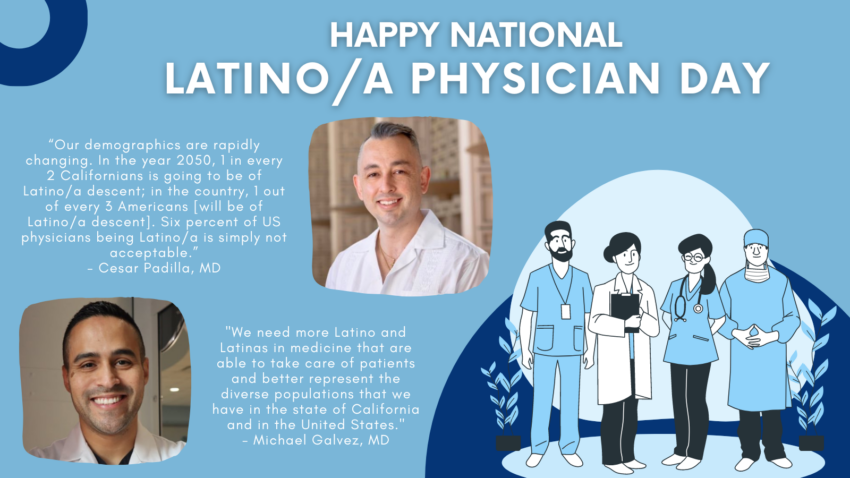
Share On Social!
Latinos make up almost 19% of the total US population, but account for only 6% of US physicians.
This lack of Latino representation in medicine negatively affects Latino patient health.
For example, Latinos may be less likely to get the care they need due to physician implicit bias and language and cultural barriers.
Studies also show that a lack of diversity in healthcare workers contributes to heath inequities, such as higher rates of maternal health issues in Latinas and worse health outcomes for Latino cancer patients, compared to their white counterparts.
To boost diversity, Drs. Michael Galvez and Cesar Padilla are leading the effort to celebrate Oct. 1, 2022, as National Latino/a Physician’s Day.
“We need more Latino and Latinas in medicine that are able to take care of patients and better represent the diverse populations that we have in the state of California and in the United States,” said Galvez of Valley Children’s Healthcare in Madera, Calif.
Padilla, a clinical assistant professor at Stanford Medicine Children’s Health, stressed the need for diverse physicians amid a rapidly changing nation.
“In the year 2050, 1 in every 2 Californians is going to be of Latino/a descent; in the country, 1 out of every 3 Americans [will be of Latino/a descent]. Six percent of US physicians being Latino/a is simply not acceptable,” said Padilla, who is also known as @TheMillennialMD on Twitter.
Support the movement to celebrate National Latino/a Physician’s Day on October 1!
Proceeds go to MiMentor, a national organization committed to addressing the lack of Latino physicians through mentorship opportunities.
Why is There a Lack of Latino Physicians?
Latinos are at a disadvantage when it comes to the education and training required to become a physician.
These disadvantages begin with generations of Latinos facing an array of inequities, such as systemic racism, discrimination, lack of financial resources, and ability to afford basic needs like food and housing.
These inequities increase Latino barriers to quality education as early as kindergarten.
At the college level, Latinos are far less likely than their white peers to complete their degree, and more likely to still be enrolled beyond six years on their path to a degree.
Lower college graduation rates among Latinos can partially be attributed to a lack of Latinos in higher education, similar to the underrepresentation of Latino physicians.
So, it’s not just a diversity and inclusion problem.
Latinos face more obstacles on the path to becoming a physician than their white counterparts.
What Can Be Done to Increase the Number of Latino Physicians?
Luckily, there are programs like the Alliance of Hispanic Serving Research Universities and Éxito! Latino Cancer Research Leadership Training, led by Salud America! director Dr. Amelie G. Ramirez of UT Health San Antonio, that are helping more Latinos succeed in higher education and break down the barriers to becoming a physician.
You can support Latino higher education, too.
Select your county and get a Health Equity Report Card by Salud America! at UT Health San Antonio.
In your report card, you will see maps, data, and gauges to compare health equity issues, including education levels, to the rest of your state and nation.
You can email your Health Equity Report Card to local leaders to stimulate community change. Use the data in your materials or share on social media to raise awareness.
GET YOUR HEALTH EQUITY REPORT CARD!
Explore More:
Health EquityBy The Numbers
142
Percent
Expected rise in Latino cancer cases in coming years



